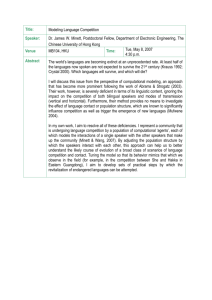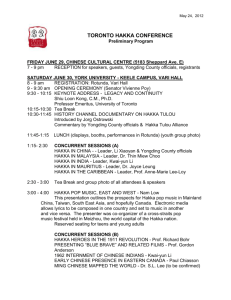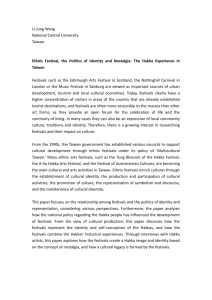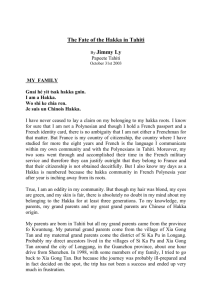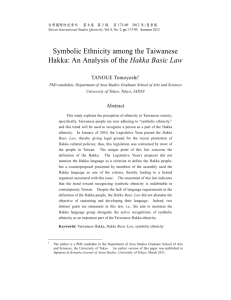Symbolic Ethnicity among the New Generation of Taiwanese Hakka
advertisement
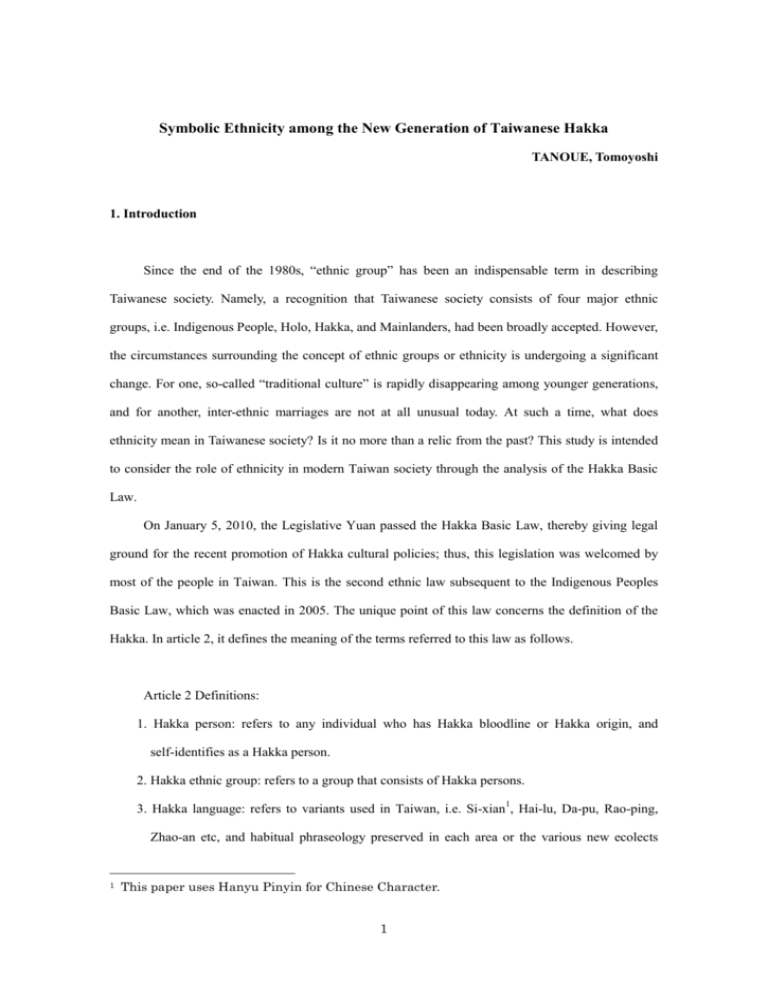
Symbolic Ethnicity among the New Generation of Taiwanese Hakka
TANOUE, Tomoyoshi
1. Introduction
Since the end of the 1980s, “ethnic group” has been an indispensable term in describing
Taiwanese society. Namely, a recognition that Taiwanese society consists of four major ethnic
groups, i.e. Indigenous People, Holo, Hakka, and Mainlanders, had been broadly accepted. However,
the circumstances surrounding the concept of ethnic groups or ethnicity is undergoing a significant
change. For one, so-called “traditional culture” is rapidly disappearing among younger generations,
and for another, inter-ethnic marriages are not at all unusual today. At such a time, what does
ethnicity mean in Taiwanese society? Is it no more than a relic from the past? This study is intended
to consider the role of ethnicity in modern Taiwan society through the analysis of the Hakka Basic
Law.
On January 5, 2010, the Legislative Yuan passed the Hakka Basic Law, thereby giving legal
ground for the recent promotion of Hakka cultural policies; thus, this legislation was welcomed by
most of the people in Taiwan. This is the second ethnic law subsequent to the Indigenous Peoples
Basic Law, which was enacted in 2005. The unique point of this law concerns the definition of the
Hakka. In article 2, it defines the meaning of the terms referred to this law as follows.
Article 2 Definitions:
1. Hakka person: refers to any individual who has Hakka bloodline or Hakka origin, and
self-identifies as a Hakka person.
2. Hakka ethnic group: refers to a group that consists of Hakka persons.
3. Hakka language: refers to variants used in Taiwan, i.e. Si-xian1, Hai-lu, Da-pu, Rao-ping,
Zhao-an etc, and habitual phraseology preserved in each area or the various new ecolects
1
This paper uses Hanyu Pinyin for Chinese Character.
1
which emerged because of adding modern vocabulary.
4. Hakka population: refers to statistical results of population research conducted by the
Council for Hakka Affairs, Executive Yuan.
5. Hakka Affairs: refers to public affairs concerned with the Hakka ethnic group.
Ordinarily, we would consider the ability to speak the Hakka language to be the most
important criterion in determining whether an individual is Hakka or not. Although architecture,
cuisine, clothing, or religious belief are also presented as Hakka culture, it is almost impossible to
show common cultural characteristics shared among people who are called Hakka. However, this
law does not consider language as a criterion for the definition of Hakka ethnicity because an
increasing number of young Hakka people cannot fluently speak or even understand the Hakka
language. Under such a circumstance, it is difficult to consider the language as an indicator for
identifying Hakka people. This study explains the perception of Hakka ethnicity in Taiwanese
society; specifically, Taiwanese people are now adhering to "symbolic ethnicity," and this trend will
be used to recognize it as a part of the Hakka ethnicity.
"Symbolic ethnicity" is a concept that has been used to refer to the ethnicity of the descendants
of European immigrants in the United States. In the early 20th century, the expectation was widely
accepted that the immigrants from various countries would be assimilated into American society;
hence that ethnicity would gradually lose its role. M. Hansen, in contrast to the straight-line
assimilation theory, focused attention on the intergenerational differences of ethnicity. Hansen
discussed, that compared to the second generation (the sons and daughters of immigrants), who
wanted to forget and lose as many of the evidence of their foreign origin as they could shuffle off,
the attitude of the third generation toward culture of immigrant generation was wildly different.
They were American-born, and their speech was the same as that of those with whom they
associated. Thus, the third generation had no reason to feel any inferiority. H. Gans argued the role
of ethnicity in the third and fourth generation, and expressed that a new kind of ethnic involvement
might be occurring among them. Gans coined the term “symbolic ethnicity” to indicate the ethnicity
2
of white Americans whose ethnic characteristics had disappeared. In his view, this symbolic
ethnicity is characterized by a nostalgic allegiance to the culture of the immigrant generation, or that
of the old country: a love for and a pride in a tradition that can be felt without having to be
incorporated in everyday behavior (Gans, 1979).
2. The Hakka movement and Hakka cultural policy
The purpose of the Hakka Basic Law is to give legal ground for the recent promotion of
Hakka cultural policies. In this section, let us take a glance at the history of the Hakka ethnic
movement and Hakka cultural policies that began to be implemented subsequent to the movement.
In Taiwan, since the early 1980s, the environment for civil society and NGOs has changed
dramatically, allowing for many and autonomous NGOs to become established entirely on the basis
of local initiative and resources. The social movement NGOs established in this period facilitated
and fostered Taiwan’s democratic transition and transformed the power relationship between the
state and civil society (Hsiao, 2006:226). Social movements in this period span a wide range of
issues, e.g., environment, aborigine, gender, labors, peasants, etc. Then each group began to claim
their own interest toward authority. The Hakka movement, which began at the end of the 1980s, the
same as the aboriginal movement, was focused on the ethnic problem.
The main issue of the Hakka movement was the language problem. The indigenous languages
in Taiwan (Holo, Hakka, and the aboriginal languages) had been given low status under the “national
language movement” until the 1980s. These languages had been positioned as “dialects,” and were
strictly prohibited in the schools and restricted in the media. As the result of the “national language
movement,” Mandarin had spread all over Taiwan as “the national language,” however, indigenous
tongues were no longer passed on to younger generation.
The beginning of the Hakka Movement goes back to the publication of a magazine Hakka
Storm (Kejia fengyun) by some Hakka people in 1987. They also established the Association for
Promoting Hakka Interest (Kejia quanyi cujinhui), which held a massive demonstration at the end of
3
1988 in which 6000–7000 people came from all over Taiwan to join in. In this demonstration, they
employed the slogan “reclaim mother tongue to me,” and demanded to open TV programs in the
Hakka language, to revise article 20 of the Broadcasting and Television Act from a restrictive clause
to a guarantee clause about dialect usage, and to establish a pluralistic and open language policy
(Hakka Storm 15:57, 1989).
Following the Hakka ethnic movement to require the recognition of identity and to preserve
their culture, the government started to implement policies intended for the protection and
development of Hakka culture. On the central level, the Council for Hakka Affairs was founded in
June 2001, and the organizations that deal with Hakka affairs were created in some of the local
governments.
Hakka cultural policy, which has been carried out in recent years, can be divided into three
main aspects: preservation of the Hakka language, encouragement of academic research about
Hakka, and promotion of Hakka culture. Similar to other indigenous languages in Taiwan, the Hakka
language began to be taught in elementary and junior high school, and a Hakka TV channel
producing programs mainly in the Hakka language was established in July 2003. On the aspect of
academic research, several research centers and graduate schools focused on Hakka have been
established in universities all over Taiwan. Concerning the promotion of culture, and in order to
introduce their culture, several Hakka cultural parks have been built, and Hakka cultural festivals are
being held every year in many cities.
3. Contents of the Hakka Basic Law
The draft of the Hakka Basic Law was sent from Executive Yuan to Legislative Yuan on
October 30, 2009. At the same time the other draft made out by four members of Legislative Yuan,
i.e., Guan Bi-ling, Qiu Yi-ying, Hou Cai-feng and Ke Jian-ming, also was sent there, apart from
them 22 members of Legislative Yuan were cosignatories of this draft. Although the content of this
law that finally passed Legislative Yuan was based on the draft by Executive Yuan, some
4
amendments had been added to the bill during the enactment process.
Deliberation on the two drafts of the Hakka Basic Law started in the Ministry of the Interior
on December 28, 2009, and the bill was passed in the Legislative Yuan on January 5, 2010, and was
promulgated on January 27. Hereinafter, according to Zhong Guo-yun’s grouping, let us show the
content of the Hakka Basic Law (Zhong, 2010:58-72).
(1) Definition of terms
Article 2 provides the definition of terms mentioned in this law. Please refer to Introduction.
(2) Actor of policy implementation
Article 3 and article 4 stipulate that Executive Yuan shall establish a promotion committee and may
convene with a meeting consisting of a committee chairman and ministers related to Hakka affairs.
(3) Area development plan and priority cultural development areas
Article 5 provides that the government shall consider the interest and development of the Hakka
ethnic group in formulating a policy and planning area development. Article 6 provides that the
government shall designate townships, cities, and districts where over one third of the population is
Hakka as priority cultural development areas, and enhance inheritance of the Hakka culture,
language, and cultural industry. Specifically, in priority cultural development areas, place the Hakka
language as an official language, and civil servants and teachers in these areas shall improve the
ability of the Hakka language.
(4) Addition of the category of the national examination concerned with Hakka
Article 7 provides that the government shall have a category related to Hakka affairs in national
examination. In response to this, civil service exams were added to a new Hakka affairs executive
category in 2010.
(5) Stipulations concerned with the Hakka language
Article 8 provides that the government shall administer a Hakka Language Certification examination
and build a database of the Hakka language in order to encourage the restoration of inheritance,
development of research, and cultivation of human resources. Article 9 provides that the government
5
agency shall realize a barrier-free environment for the Hakka language. Article 10 provides that the
government shall offer intensive measures, and make an effort to integrate schools, families, and
communities, so as to develop a learning environment for the Hakka language.
(6) Right of access to media
Article 12 provides that the government shall guarantee the right of the Hakka ethnic group to access
the media and help to establish a nationwide radio and television channel.
(7) Academic research about Hakka and global Hakka cultural exchange
Article 11 provides that the government shall encourage and promote academic research about
Hakka, and to establish graduate schools, undergraduate schools, and academic courses related to
Hakka. Article 13 provides the government to promote integrating the global Hakka ethnic group,
and let Taiwan become a center of exchanges and researches of global Hakka culture.
(8) National Hakka Day
Article 14 provides that the government shall determine a National Hakka Day, so as to manifest the
Hakka ethnic group’s contribution to multiculturalism in Taiwan.
Most of the contents of drafts are in common between The Executive Yuan's proposal and the
counterproposal made by legislators, the most controversial issue related to the enactment process
for the Hakka Basic Law was associated with the definition of Hakka people. The next section will
show the argument about the definition of Hakka people in the Legislative Yuan.
4. The argument about the definition of Hakka people
As previously intimated, Article 2 of the Hakka Basic Law shows the definition of the terms
related to this law. Although the promulgated bill provides the definition of a Hakka person as “any
individual who has Hakka bloodline or Hakka origin, and self-identifies as a Hakka person,” neither
the Executive Yuan's proposal nor the counterproposal showed the same definition of Hakka people.
The Executive Yuan's proposal defines a Hakka person as “any individual who has Hakka bloodline
or Hakka origin, or is familiar with the Hakka language and culture, and self-identifies as a Hakka
6
person,” and the counterproposal made by legislators defines a Hakka person as “any individual who
has Hakka bloodline, and is familiar with the Hakka language, and self-identifies as a Hakka person”
(The Legislative Yuan Gazette 99(4), 2010).
Shih Cheng-feng cites three elements as criteria of Hakka ethnicity. Figure 1 shows the
structure of Hakka ethnicity (Shih, 2004:43-46).
Hakka bloodline
f
e
b
h
a
g
d
c
Hakka language
Figure 1
Hakka identity
The structure of Hakka ethnicity
Note:
a: Any individual who self-identifies as a Hakka person, and recognizes that he/she has Hakka
bloodline, and can speak the Hakka language.
b: Any individual who self-identifies as a Hakka person, and recognizes that he/she has Hakka
bloodline, and cannot speak the Hakka language.
c: Any individual who self-identifies as a Hakka person, and denies that he/she has Hakka bloodline,
and can speak the Hakka language.
d: Any individual who self-identifies as a Hakka person, and denies that he/she has Hakka bloodline,
and cannot speak the Hakka language.
7
e: Any individual who self-identifies as not a Hakka person, and recognizes that he/she has Hakka
bloodline, and can speak the Hakka language.
f: Any individual who does not self-identify as a Hakka person, and recognizes that he/she has
Hakka bloodline, and cannot speak the Hakka language.
g: Any individual who does not self-identify as a Hakka person, and denies that he/she has Hakka
bloodline, and can speak the Hakka language.
h: Any individual who does not self-identify as a Hakka person, and denies that he/she has Hakka
bloodline, and cannot speak the Hakka language.
Source: Shih (2004)
Let us now compare the definition of Hakka people by the Executive Yuan's proposal and that
by the counterproposal made by legislators in reference to Figure 1. The scope of the
counterproposal is very clear, as it contains all individuals who meet the criteria of self-identity,
bloodline, and language, which correspond to the set {a}. The Executive Yuan's proposal demands
the criteria of bloodline or culture/language, and self-identity, thus it corresponds to the sets {a, b, c}.
Actually, the set {d} is almost non-existent; the Executive Yuan's proposal is virtually the same and
considers that everyone who identifies him/herself as a Hakka person is a Hakka person.
As a result of the discussion by the Legislative Yuan, they decided to adopt bloodline as well
as self-identity as criteria in determining whether an individual is a Hakka person or not, but
language was excluded from the list of criteria. It corresponds to the sets {a, b} in Figure 1.
5. Recognition of symbolic ethnicity
From the discussion above, we can conclude as follows. First, subjective criterion is becoming
more important in recognizing Hakka ethnicity. The definition of Hakka people in the Hakka Basic
Law is one of the obvious proofs of it. Second, plurality of ethnicity is being placed with more
emphasis than singularity. The enactment of the Hakka Basic Law shows that the argument was
8
based on the assumption that an individual has plural ethnicity. As the result of the argument in the
Legislative Yuan, the Executive Yuan's proposal passed, thereby indicating that the trend toward
recognizing symbolic ethnicity is indubitable in contemporary Taiwan.
Enactment of the Hakka Basic Law is expected to promote Hakka cultural policies that intend
to restore the Hakka language, and at the same time indicate that those who cannot understand the
Hakka language, especially younger generations, are going to be involved in the targets of Hakka
cultural policy. If the young Hakka generation who grew up far away from the traditional settlements
of Hakka people sustain or acquire Hakka ethnicity, it should be inevitable that their ethnicity
become symbolic, further increasing the number of young Hakka people who cannot speak their
mother tongue well in the traditional settlements. From this circumstance, one may say that Hakka
ethnicity all over Taiwan is approaching symbolic ethnicity.
However, the new style of Hakka ethnicity is quite different from that of the Hakka movement
in the 1980s. In the “reclaim mother tongue to me” movement, they declared the Hakka movement
was the movement aiming to preserve the dignity of their mother tongue and their continuity as a
language group, and it was necessary for them to protect their perfect dignity as human beings. Of
course it also has to be noted that the social consensus about the definition of Hakka people has not
been fully formulated.
Although the new definition of Hakka refers to a different style of ethnicity as compared to
that of the Hakka cultural movement in the 1980s, the redefinition of the Hakka ethnicity is
meaningful due to the inclusion of the young Hakka generation, many of whom speak Mandarin as
their first language instead of the Hakka language. Despite the lack of language requirements in the
definition of the Hakka people, the Hakka Basic Law did not abandon the objective of sustaining and
developing their language. Indeed, two distinct goals are immanent in this law, i.e., the aim to
maintain the Hakka language group alongside the active recognitions of symbolic ethnicity as an
important part of the Taiwanese Hakka ethnicity.
References
9
Gans, Herbert, “Symbolic Ethnicity: The Future of Ethnic Groups and Cultures in America,” Ethnic
and Racial Studies 2(January 1979),pp. 1–20.
Hansen, Marcus Lee, The Problem of the Third Generation Immigrant, Rock Island, Illinois:
Augustana Historical Society, 1938. Reprinted in Edward N. Saveth, ed., Understanding the
American Past: American History and Its Interpretation, Boston: Little, Brown, 1954, pp.
472–488.
Hsiao, Hsin-Huang Michael,“Civil Society and Democratization in Taiwan: 1980–2005,”HsinHuang Michael Hsiao, ed., Asian New Democracies: The Philippines, South Korea and Taiwan
Compared, Taipei: Taiwan Foundation for Democracy, 2006, p. 226.
Shih, Cheng-feng, Hakka Politics and Policy in Taiwan, Taipei, Xinxin Taiwan Wenhua Jiaoyu
Jijinhui, 2004.
Zhong Guo-yun, “An analysis of Hakka Basic Law,” Ming-xiu Jiang, ed., Political and Economic
Analysis of Hakka, Taipei: BestWise Co., Ltd., 2010, pp.49-78.
Hakka Storm 15, Taipei, Hakka Storm Magazine, 1989
The Legislative Yuan Gazette 99(4), 2010
10

